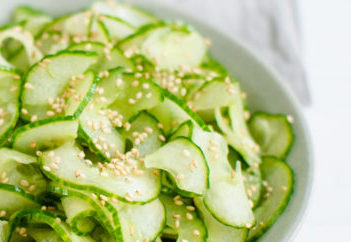These ratios were presented by Chef Tatsuo Saito from NHK World Dining with the Chef. Other information has been researched and is presented here.
Base Ingredients
- Soy provides saltiness with a touch of umami
- Salt – Both soy and salt work to complete the electrical impulses needed for taste.
- Mirin (sweet rice wine) provides a complex sweetness
- Sugar provides a simple sweetness
- Sake provides depth
– Sake also removes fishy odors
- Vinegar is a fermented and distilled liquid that adds layers of flavor.
- Miso is a paste made from fermented soybeans and barley or rice malt, used in Japanese cooking. Frequently used for soup.
Taste each individual ingredient so that you can better understand what each ingredient is bringing to the dish.
Teriyaki Sauce
- 2 parts soy
- 2 parts sake
- 3 parts mirin
You can use sugar in place of mirin, but it makes a heavier tasting teriyaki.
Sukiyaki
- 1 part dashi
- 2 parts soy
- 1 part sugar
- 1 part mirin
Tempura
- 4 parts dashi
- 1 part soy
- 1 part mirin
Ohitashi (spinach)
- 8 parts dashi
- 1 part soy
- 1 part mirin
White Fish
Liquid to simmer fish
- 3 parts water
- 1 part soy
- 3 parts sake
- 1 part mirin
Hot Soba Soup
- 10 parts dashi
- 1 part soy
- 1 part mirin
The same as Tempura liquid, but with more dashi
Simple Recipe of Rice
- Bring 2 parts water (2 C) to a boil.
- Add 1 part rice (1 C) and bring back to a boil.
- Reduce heat to lowest setting, cover and simmer 10 minutes.
- Remove from heat, keeping covered, and let rest another 10 minutes.
- Fluff with a fork and serve in very loose clumps.
Dashi
This is an incredibly simple, clear and unassuming broth It forms one of the culinary cornerstones of Japanese cooking.
- Kombu Dashi is made in about 20 minutes with just three ingredients: water, kombu (dried kelp), and bonito fish flakes. The resulting clear broth tastes like the essence of the sea.
- Niboshi Dashi uses baby dried sardines in place of the kombu.
- Shitake Dashi uses Shitake mushrooms in the place of kombu. It is also not heated to boiling, as that destroys the delicate taste of Shitake.
- Awase Dashi is essentially Kombu Dashi that after simmering is allowed to sit for awhile to let the flavors leech from the contents. It has a stronger flavor than Kombu Dashi.
Dashi is used in any Japanese dish that requires liquid for cooking. It’s also found at the heart of the soup broth in various broth-based dishes like nabe (hot pot), shabu shabu, sukiyaki, and oden. Mixed with soybean paste and a few cubes of tofu, dashi makes a flavorful miso soup.
Dashi mixed with a bit of soy sauce, sugar, and mirin (sweet rice wine) can be used to make dipping sauces for fried tempura or chilled noodle dishes like soba buckwheat noodles and udon flour noodles. A greater amount of hot dashi broth can also be added to dipping sauce or broth or a hot noodle soup. In addition to noodles, dashi can be cooked with rice and mushrooms, vegetables, and fish or meat to make takikomi-gohan.
Ohitashi literally means ‘steeped in dashi’ and is a common way of cooking vegetables. Some popular dishes include okra ohitashi, spinach ohitashi and eggplant ohitashi. Nimono, or simmered dishes, using dashi broth are another large part of Japanese home cooking. This includes staples like nikujaga (boiled meat and potatoes), kabocha no nimono (simmered Japanese pumpkin), buri-daikon (braised yellowtail with daikon radish), and buta no kakuni (stewed pork belly). Dashi can also be mixed in with eggs to make dashimaki tamago, a Japanese rolled omelet.
Dried kombu sheets, shiitake mushroom, and bonito flakes can all be purchased separately to make dashi. In addition, commercial dashi concentrate—available in instant powdered granules, liquid concentrate, or pre-made broth pouches—has become incredibly popular in Japan. Look for it in the Asian or international food section of your local supermarket, at Asian grocers, in health food stores, or from specialty vendors online.
Commercial dashi is so convenient and popular in Japan that making dashi from scratch is becoming a bit of a dying art. However, nothing beats the well-rounded flavor of homemade dashi broth, and a simple dashi can be made easily overnight or with a quick 30 minutes of preparation, so it’s worth it to try making dashi from scratch.


